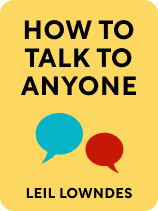

This article is an excerpt from the Shortform book guide to "How to Talk to Anyone" by Leil Lowndes. Shortform has the world's best summaries and analyses of books you should be reading.
Like this article? Sign up for a free trial here .
What does it mean when someone fidgets a lot during an interaction? How does fidgeting influence people’s impressions of you?
When it comes to body language, fidgeting is one of the things you should avoid. Your fidgeting may have nothing to do with your intentions, but people interpret it as insincerity. To make a positive impression, remove physical barriers and maintain an open stance when you are talking to someone.
Here’s why you should avoid fidgeting in your body language.
Avoid Fidgeting
Communications expert Leil Lowndes claims that people interpret fidgeting body language and guarded movements as insincerity because they make you look suspicious and defensive:
- Fidgety movements, such as shuffling your feet or touching your face, come across as signs of discomfort, tension, or distraction.
- Guarded movements, such as folding your arms or clutching something in front of your body, also convey discomfort. Additionally, they give the impression that you’re placing barriers between yourself and other people.
On the other hand, Lowndes argues, people interpret a relaxed and open stance as a sign of an honest and welcoming personality because it signals that you’re calm, unafraid of appearing vulnerable (because you have nothing to hide), and approachable. To come across as calm, self-assured, and trustworthy, practice keeping your arms loosely by your sides with your palms and wrists faced upwards. If you’re approached by people you want to talk to, turn your body totally towards them to show them they’ve got your full attention—this implies that you’re happy to be in their company and puts them at ease.
(Shortform note: Why keep your palms and wrists faced upwards? According to psychologists, primitive survival instincts lead you to unconsciously perceive closed or hidden palms as a sign of danger—if you can’t see someone’s hands, you don’t know if they’re holding a weapon. In addition to the open body language Lowndes describes, you can reduce uncertainty about your intentions by tilting your head to one side. Exposing your neck—one of the most vulnerable areas of your body—signals that you’re very comfortable around others and have no intention of causing harm.)
18 Fidgety and Guarded Movement to Avoid
Marc Chernoff, the author of Getting Back To Happy, expands on what Lowndes has to say about fidgety and guarded movements. He provides a list of 18 gestures that you should avoid doing around the people you want to talk to and explains the signals each sends:
Holding objects in front of your body: This indicates shyness, resistance, and a need to separate yourself from others. Instead, carry objects by your side.
Checking the time or inspecting your fingernails: This indicates a strong sign of boredom.
Picking lint off your clothes while talking to someone: This indicates that you disapprove of someone’s ideas and feel uneasy about giving an honest opinion.
Stroking your chin while looking at someone: This indicates that you’re making a judgmental decision about this person.
Touching your face during a conversation: This indicates deception, especially when you touch your nose or your mouth.
Leaning away from someone: This indicates disinterest and dislike, especially when you’re sitting around a table.
Resting hands behind the head or the hips: This indicates superiority or arrogance and should only be used when you’re in the presence of close friends or family.
Not directly facing the person you’re speaking to: This indicates discomfort, disinterest, and a lack of commitment to the conversation.
Crossing your arms: This indicates defensive resistance and sometimes egotism. Always keep your arms open and at your sides.
Scratching the back of your head and neck: This indicates doubt and can be interpreted as deception.
Fiddling with your shirt collar: This indicates extreme discomfort and nervousness.
Crossing your hands over your genitals: This indicates that you feel nervous and vulnerable. It has the added effect of pushing your shoulders forward—making you appear smaller and weaker.
Propping up your head with your hands: This indicates boredom. Instead, place your hands on the table and keep them at rest.
Wiping sweaty hands on your clothes: This indicates that you’re frantically nervous.
Sitting on the edge of your chair: This indicates that you’re mentally and physically uncomfortable.
Foot and finger tapping: This indicates stress, impatience, or boredom.
Fidgeting with small objects: This indicates anxiety or a lack of preparation.
Shifting body weight from foot to foot: This indicates mental and physical discomfort and implies that you’re ready to leave the conversation.

———End of Preview———
Like what you just read? Read the rest of the world's best book summary and analysis of Leil Lowndes's "How to Talk to Anyone" at Shortform .
Here's what you'll find in our full How to Talk to Anyone summary :
- Practical techniques to help you overcome social discomfort
- How to confidently develop new connections
- How to appear more likable without saying a word






